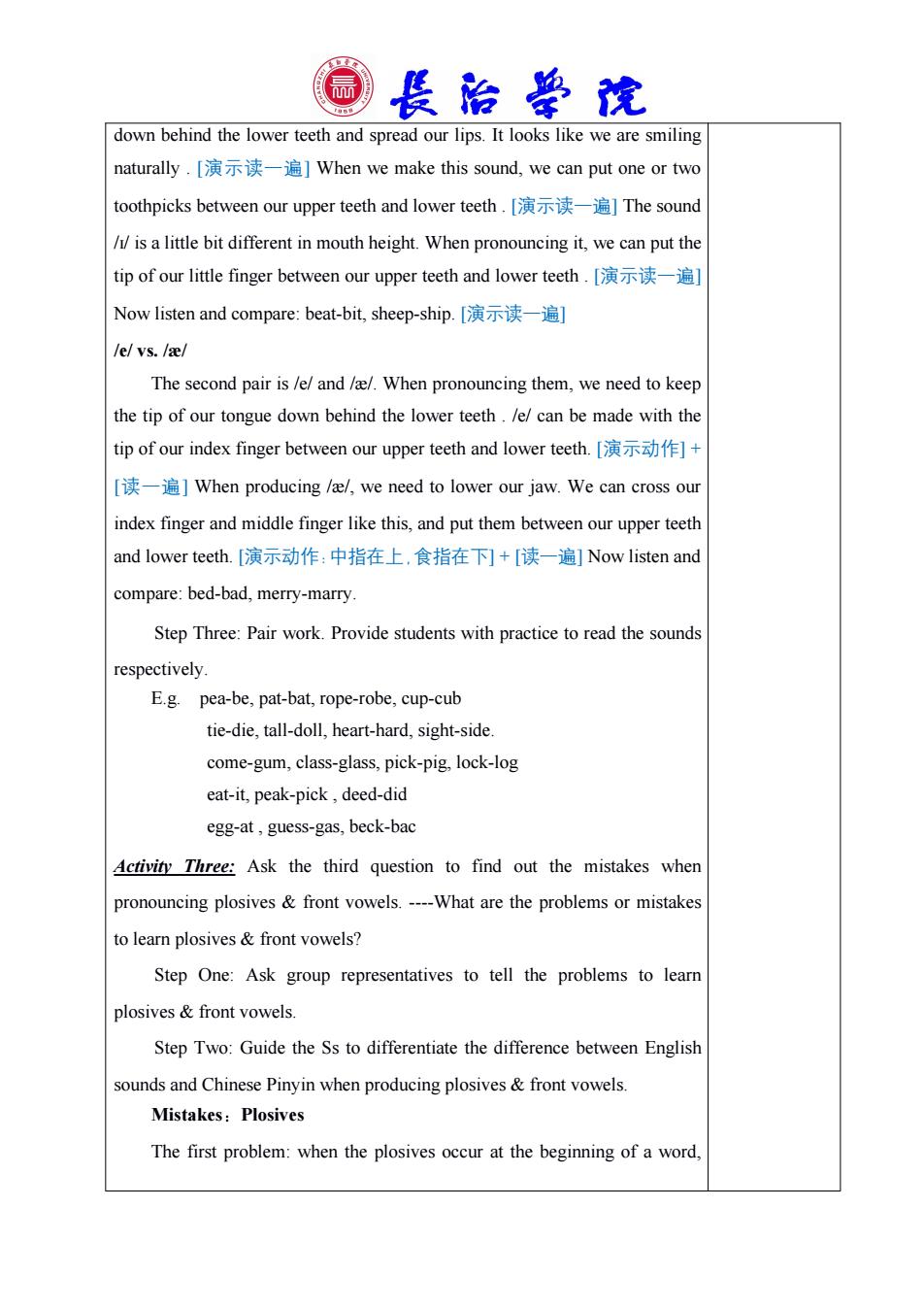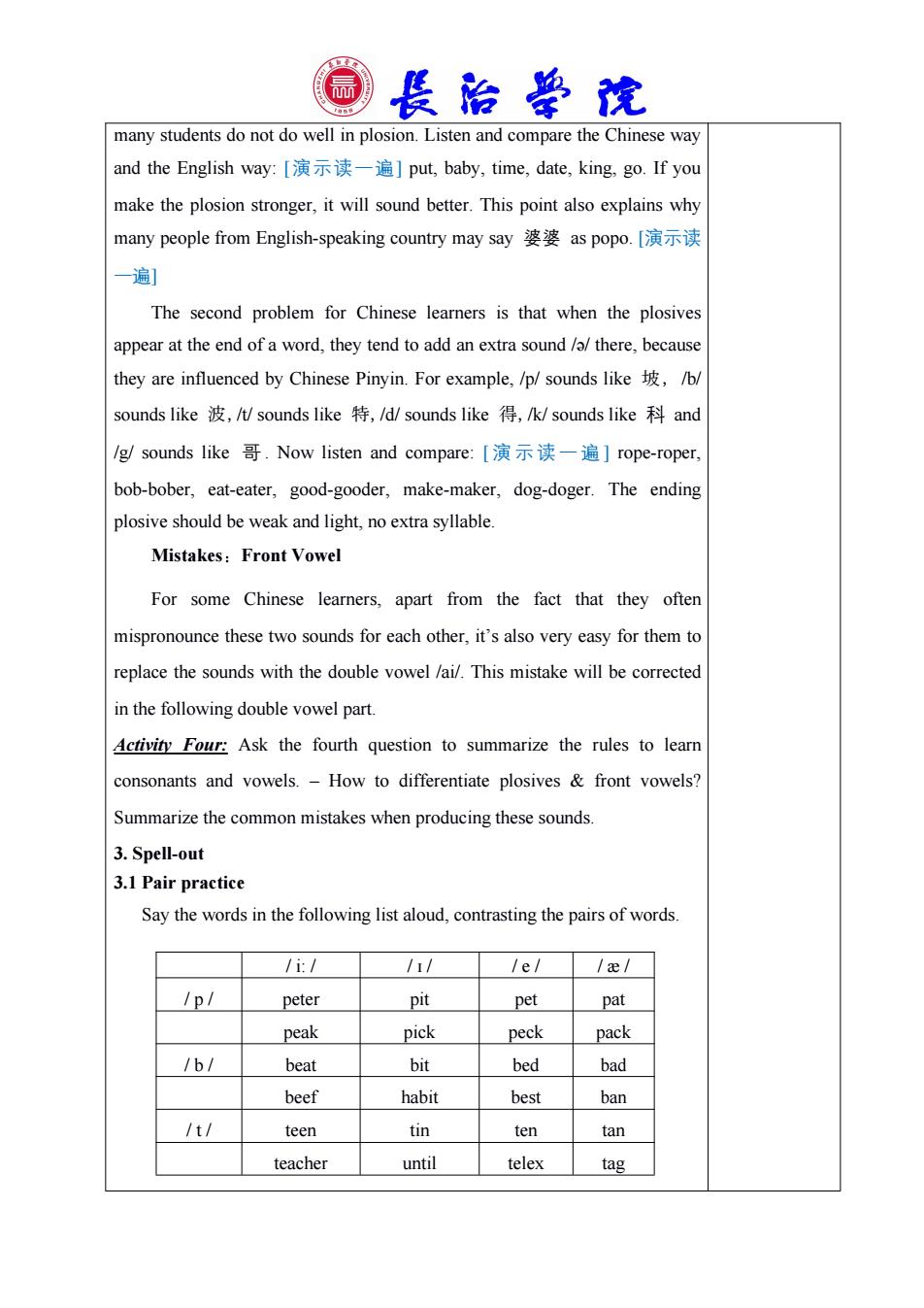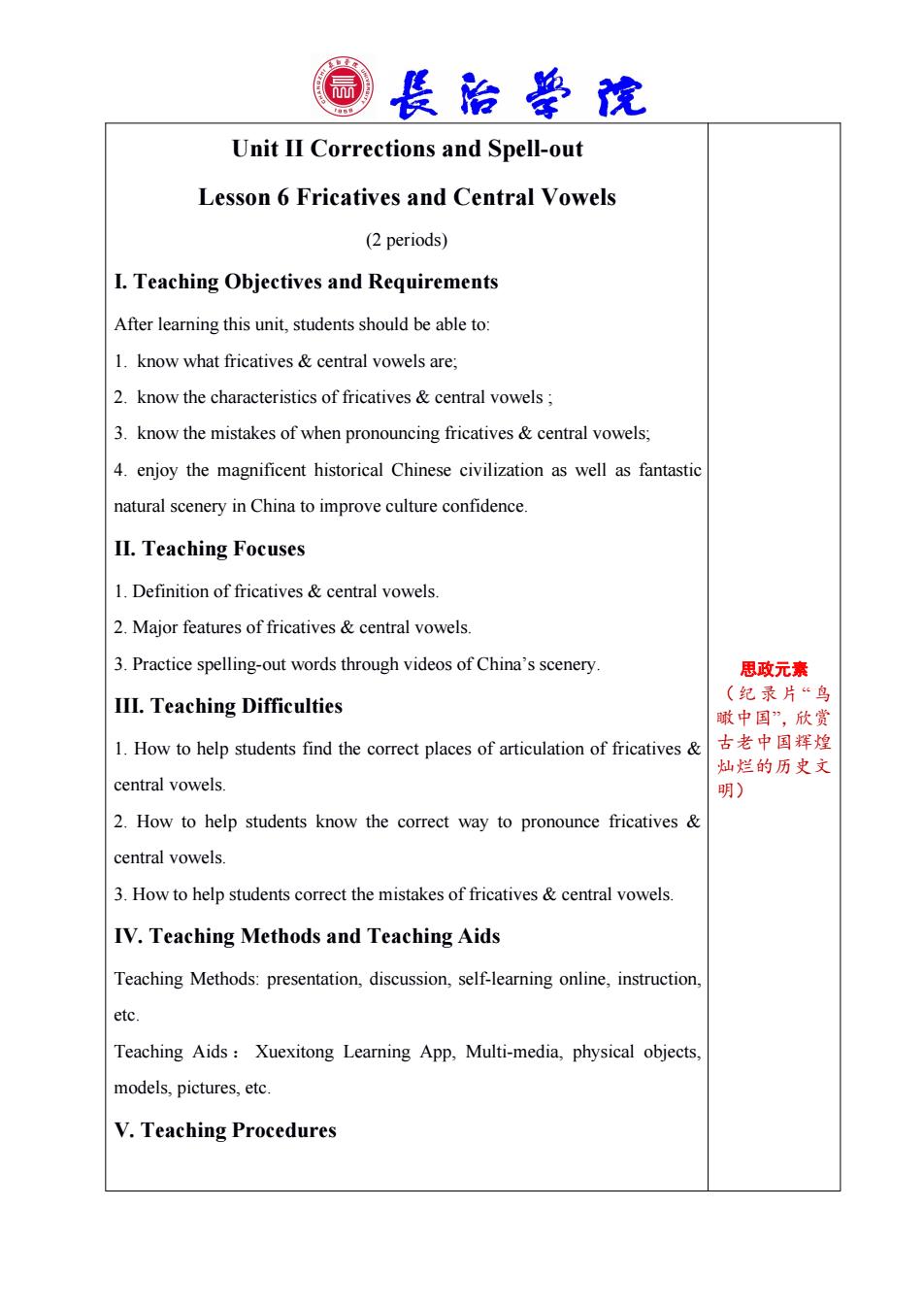
司畏胎堂沈 down behind the lower teeth and spread our lips.It looks like we are smiling naturally.[演示读-遍]When we make this sound,.we can put one or two oothpicks between our upper teeth and lower teeth.[演示读-遍]The sound is a little bit different in mouth height.When pronouncing it,we can put the tip of our litte finger between our upper teeth and lower teeth.[演示读-遍] Now listen and compare::beat-bit,sheep-ship.[演示读一遍] el vs.a The second pair is /e/and //When pronouncing them,we need to keep the tip of our tongue down behind the lower teeth./e/can be made with the tip of our index finger between our upper teeth and lower teeth.[演示动作 [When producing /a/,we need to lower our jaw.We can cross our index finger and middle finger like this,and put them between our upper teeth and lower teeth.[演示动作:中指在上,食指在下)+[读一遍]Now listen and compare:bed-bad,merry-marry. Step Three:Pair work.Provide students with practice to read the sounds espectively. E.g.pea-be,pat-bat,rope-robe,cup-cub tie-die,tall-doll,heart-hard,sight-side. come-gum,class-glass,pick-pig.lock-log eat-it,peak-pick,deed-did egg-at,guess-gas,beck-bac Activity Three:Ask the third question to find out the mistakes when pronouncing plosives&front vowels.-What are the problems or mistakes to learn plosives&front vowels? Step One:Ask group representatives to tell the problems to learn plosives&front vowels. Step Two:Guide the Ss to differentiate the difference between English sounds and Chinese Pinyin when producing plosives front vowels. Mistakes:Plosives The first problem:when the plosives occur at the beginning of a word
down behind the lower teeth and spread our lips. It looks like we are smiling naturally . [演示读一遍] When we make this sound, we can put one or two toothpicks between our upper teeth and lower teeth . [演示读一遍] The sound /ɪ/ is a little bit different in mouth height. When pronouncing it, we can put the tip of our little finger between our upper teeth and lower teeth . [演示读一遍] Now listen and compare: beat-bit, sheep-ship. [演示读一遍] /e/ vs. /æ/ The second pair is /e/ and /æ/. When pronouncing them, we need to keep the tip of our tongue down behind the lower teeth . /e/ can be made with the tip of our index finger between our upper teeth and lower teeth. [演示动作] + [读一遍] When producing /æ/, we need to lower our jaw. We can cross our index finger and middle finger like this, and put them between our upper teeth and lower teeth. [演示动作:中指在上,食指在下] + [读一遍] Now listen and compare: bed-bad, merry-marry. Step Three: Pair work. Provide students with practice to read the sounds respectively. E.g. pea-be, pat-bat, rope-robe, cup-cub tie-die, tall-doll, heart-hard, sight-side. come-gum, class-glass, pick-pig, lock-log eat-it, peak-pick , deed-did egg-at , guess-gas, beck-bac Activity Three: Ask the third question to find out the mistakes when pronouncing plosives & front vowels. -What are the problems or mistakes to learn plosives & front vowels? Step One: Ask group representatives to tell the problems to learn plosives & front vowels. Step Two: Guide the Ss to differentiate the difference between English sounds and Chinese Pinyin when producing plosives & front vowels. Mistakes:Plosives The first problem: when the plosives occur at the beginning of a word

6長胎堂沈 many students do not do well in plosion.Listen and compare the Chinese way and the English way:[演示读一遍]put,baby,time,date,king,go.If you make the plosion stronger,it will sound better.This point also explains why many people from English-speaking country may say婆婆as popo.[演示读 遍] The second problem for Chinese learners is that when the plosives appear at the end of a word,they tend to add an extra sound /a/there,because they are influenced by Chinese Pinyin.For example,/p/sounds like,/b/ sounds like波,sounds like特,/d/sounds like得,/k/sounds like科and /g/sounds like哥.Now listen and compare:[演示读-遍]rope-roper. bob-bober,eat-eater,good-gooder,make-maker,dog-doger.The ending plosive should be weak and light,no extra syllable. Mistakes:Front Vowel For some Chinese learners,apart from the fact that they often mispronounce these two sounds for each other.it's also very easy for them to eplace the sounds with the double vowel /ai/.This mistake will be corrected in the following double vowel part. Activiny Four:Ask the fourth question to summarize the rules to learn consonants and vowels.-How to differentiate plosives front vowels? Summarize the common mistakes when producing these sounds 3.Spell-out 3.1 Pair practice Say the words in the following list aloud,contrasting the pairs of words. /i:1 11/ /e//ε/ /p/ peter pit pet pat peak pick peck pack /b beat bit bed bad beef habit best ban /t/ teen ten tan teacher until telex
many students do not do well in plosion. Listen and compare the Chinese way and the English way: [演示读一遍] put, baby, time, date, king, go. If you make the plosion stronger, it will sound better. This point also explains why many people from English-speaking country may say 婆婆 as popo. [演示读 一遍] The second problem for Chinese learners is that when the plosives appear at the end of a word, they tend to add an extra sound /ə/ there, because they are influenced by Chinese Pinyin. For example, /p/ sounds like 坡,/b/ sounds like 波,/t/ sounds like 特,/d/ sounds like 得,/k/ sounds like 科 and /g/ sounds like 哥 . Now listen and compare: [ 演 示 读 一 遍 ] rope-roper, bob-bober, eat-eater, good-gooder, make-maker, dog-doger. The ending plosive should be weak and light, no extra syllable. Mistakes:Front Vowel For some Chinese learners, apart from the fact that they often mispronounce these two sounds for each other, it’s also very easy for them to replace the sounds with the double vowel /ai/. This mistake will be corrected in the following double vowel part. Activity Four: Ask the fourth question to summarize the rules to learn consonants and vowels. – How to differentiate plosives & front vowels? Summarize the common mistakes when producing these sounds. 3. Spell-out 3.1 Pair practice Say the words in the following list aloud, contrasting the pairs of words. / i: / / ɪ / / e / / æ / / p / peter pit pet pat peak pick peck pack / b / beat bit bed bad beef habit best ban / t / teen tin ten tan teacher until telex tag

司畏治莹沈 Idl deed did dead Dad dean din Dennis dam /k/ keep kick kettle cab 1g1 geese give get gat 3.2Dubbing Locate the concrete sounds into the sentences and follow the video to practice dubbing 4.Practice spelling-out words through videos of Chinese poems Ask students to enjoy British documentary about one of the greatest 思政融入点:创 Chinese poets,Dufu and his poems to find the beauty of Chinese poems and 新的“他者“视 practice the spelling words appeared in the poems which have been learned in 角讲述中国故 事,提升文化自 this lesson. (思政教学内容:通过英国纪录片“杜甫中国最伟大的诗人”,将中国的历 史与文化之美首次通过诗歌形式介绍给世界,积累诗歌中章节所学单音 拼读词汇。) VI.Assignments 1.Listen to the recording and practice relevant exercises of this unit. 2.Discussion online.Say the words in the given list aloud,and upload the recording online.Make comments on others'recording,focusing on the pronunciation of plosives and front vowels. 3.Preview next chapter of this unit online. VII.References L,Baker,A.&Goldstein,S.Pronunciation Pairs(Second Edition),北京:北 京语言大学出版社,2016. 2.Hewing,M.Cambridge-English Pronunciation in Use (Advanced). Cambridge:Cambridge University Press,2007. 3. Mortimer,C.Elements of Pronunciation,Cambridge:Cambridg University Press,1997. 4.王桂珍,《英语语音教程》(第三版),北京:高等教育出版社,2022
3.2 Dubbing Locate the concrete sounds into the sentences and follow the video to practice dubbing. 4. Practice spelling-out words through videos of Chinese poems Ask students to enjoy British documentary about one of the greatest Chinese poets, Dufu and his poems to find the beauty of Chinese poems and practice the spelling words appeared in the poems which have been learned in this lesson. (思政教学内容:通过英国纪录片“杜甫-中国最伟大的诗人”,将中国的历 史与文化之美首次通过诗歌形式介绍给世界,积累诗歌中章节所学单音 拼读词汇。) VI. Assignments 1. Listen to the recording and practice relevant exercises of this unit. 2. Discussion online. Say the words in the given list aloud, and upload the recording online. Make comments on others' recording, focusing on the pronunciation of plosives and front vowels. 3. Preview next chapter of this unit online. VII. References 1. Baker, A. & Goldstein, S. Pronunciation Pairs (Second Edition), 北京:北 京语言大学出版社,2016. 2. Hewing, M. Cambridge-English Pronunciation in Use (Advanced), Cambridge: Cambridge University Press, 2007. 3. Mortimer, C. Elements of Pronunciation, Cambridge: Cambridge University Press, 1997. 4. 王桂珍,《英语语音教程》(第三版),北京:高等教育出版社,2022. / d / deed did dead Dad dean din Dennis dam / k / keep kick kettle cab / ɡ / geese give get gat 思政融入点:创 新的“他者”视 角讲述中国故 事,提升文化自 信

6畏胎尝沈 5.卜友红.英语语音教程,北京:外语教学与研究出版社,2021
5. 卜友红. 英语语音教程,北京:外语教学与研究出版社,2021

同畏胎兰沈 Unit II Corrections and Spell-out Lesson 6 Fricatives and Central Vowels (2 periods) I.Teaching Objectives and Requirements After learning this unit.students should be able to: 1.know what fricatives¢ral vowels are: 2.know the characteristics of fricatives¢ral vowels; 3.know the mistakes of when pronouncing fricatives central vowels; 4.enjoy the magnificent historical Chinese civilization as well as fantastic natural scenery in China to improve culture confidence II.Teaching Focuses 1.Definition of fricatives¢ral vowels. 2.Major features of fricatives¢ral vowels 3.Practice spelling-out words through videos of China's scenery. 思政元素 III.Teaching Difficulties (纪录片“鸟 酰中国,欣资 1.How to help students find the correct places of articulation of fricatives 古老中国辉煌 灿烂的历史文 central vowels. 2.How to help students know the correct way to pronounce fricatives& central vowels. 3.How to help students correct the mistakes of fricativescentral vowels IV.Teaching Methods and Teaching Aids Teaching Methods:presentation,discussion,self-learning online,instruction etc. Teaching Aids:Xuexitong Learning App,Multi-media,physical objects. models,pictures,etc. V.Teaching Procedures
Unit II Corrections and Spell-out Lesson 6 Fricatives and Central Vowels (2 periods) I. Teaching Objectives and Requirements After learning this unit, students should be able to: 1. know what fricatives & central vowels are; 2. know the characteristics of fricatives & central vowels ; 3. know the mistakes of when pronouncing fricatives & central vowels; 4. enjoy the magnificent historical Chinese civilization as well as fantastic natural scenery in China to improve culture confidence. II. Teaching Focuses 1. Definition of fricatives & central vowels. 2. Major features of fricatives & central vowels. 3. Practice spelling-out words through videos of China’s scenery. III. Teaching Difficulties 1. How to help students find the correct places of articulation of fricatives & central vowels. 2. How to help students know the correct way to pronounce fricatives & central vowels. 3. How to help students correct the mistakes of fricatives & central vowels. IV. Teaching Methods and Teaching Aids Teaching Methods: presentation, discussion, self-learning online, instruction, etc. Teaching Aids : Xuexitong Learning App, Multi-media, physical objects, models, pictures, etc. V. Teaching Procedures 思政元素 (纪录片“鸟 瞰中国”,欣赏 古老中国辉煌 灿烂的历史文 明)